Centuries-old baobabs get fresh roots in Chengicherla forest
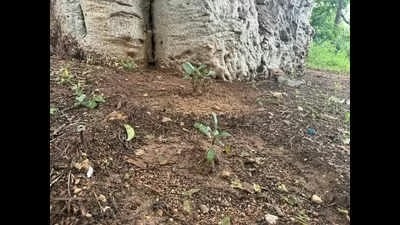
Hyderabad: In a rare ecological breakthrough, the Telangana forest department has identified around 21 naturally regenerated baobab saplings in Chengicherla forest. The discovery is particularly significant, as most baobabs in the country are believed to have been introduced by African settlers more than four centuries ago.Forest officials are now planning to translocate the saplings to a secure, isolated section of the forest. “They will be replanted and nurtured to form the core of what is set to become India’s first dedicated Baobab Park. To ensure their survival, we are also consulting independent experts to design a conservation plan tailored to the slow-growing, drought-resistant species,” said Sharat Chandra Reddy, forest range officer at the Chengicherla forest.The discovery was made during a field visit led by forest officials when one of the four baobabs in the area was felled due to pest infestation. “We were also accompanied by independent researchers specialising in baobab ecology. The saplings were found clustered around three massive, centuries-old baobabs, raising hopes that these iconic trees could be cultivated and sustained locally without relying solely on transplants,” Reddy added.Hyderabad’s baobabs—known for their bulbous trunks and extraordinary longevity—are under growing threat from age, environmental stress, and urban development, say tree experts. A recent survey by a local nature group documented 37 African baobab trees scattered across the city. The number includes a group of seven trees in the Aramghar area, with two of them inside the Jamia Islamia Darul Uloom and three inside the Zilla Parishad High School in Aramghar, with one of them having a girth of approximately 45 feet.”This underscores both their fragile survival and their cultural significance in the urban landscape. If realised, the Chengicherla Baobab Park could become a one-of-a-kind ecological and cultural landmark, linking Hyderabad’s past with a greener, more sustainable future,” said Uday Krishna, an environmentalist from the city who wrote to the district forest officer of Medchal-Malkajgiri district urging conservation of the remaining baobabs.The idea of a Baobab Park at Chengicherla is not new. “Some years ago, actor Nagarjuna donated Rs 1 crore towards its development. However, only an ornamental entrance gate was built, and no further infrastructure materialised. But this new natural regeneration will provide the momentum needed to revive the stalled project. This is a pivotal opportunity, not just to preserve these heritage trees, but to cultivate their future population as a living legacy,” said the forest beat officer of the forest.
Centuries-old baobab trees are getting a new lease on life in the Chengicherla forest near Hyderabad, India. This follows the discovery of naturally regenerated baobab saplings, a rare ecological event, after one of the four ancient trees in the area fell due to a pest infestation.
The Discovery and Conservation Efforts
Following the collapse of a 400-year-old baobab tree, forest officials and researchers found approximately 21 naturally grown baobab saplings clustered around the remaining three mature trees. This discovery is particularly significant because most baobabs in India are believed to have been introduced by African settlers over 400 years ago.
The Telangana forest department is now planning to translocate these saplings to a dedicated, secure area within the forest to ensure their survival and promote further growth. This project aims to create a unique Baobab Park, which would serve as both an ecological and cultural landmark.
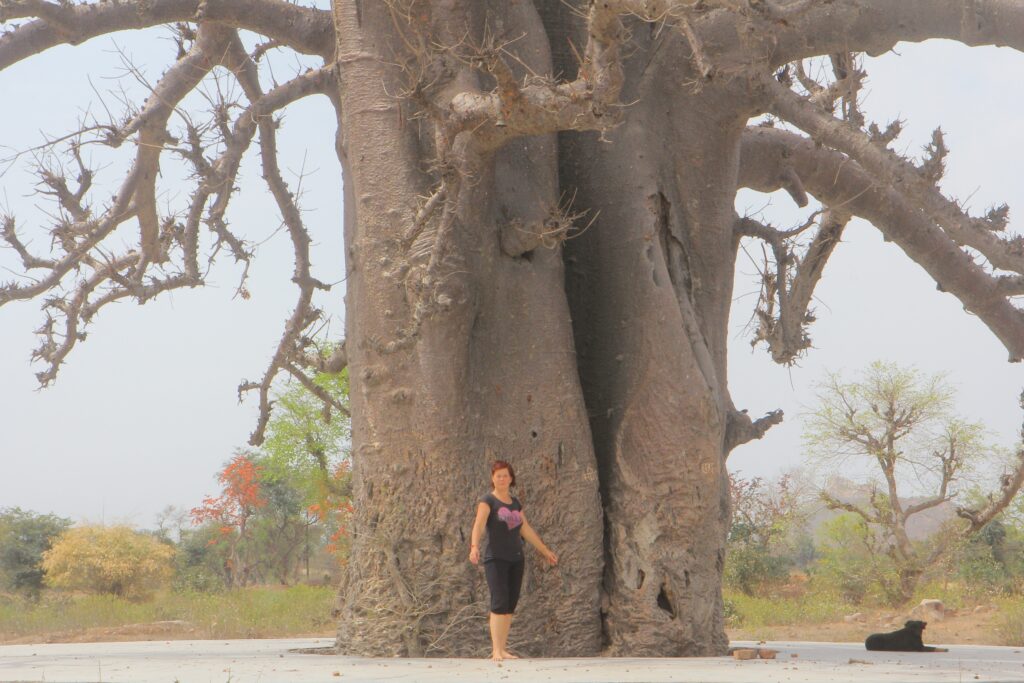
Baobabs, scientifically known as Adansonia, are native to mainland Africa and Madagascar. They are known for their massive, swollen trunks that can store large amounts of water, helping them survive in arid climates. The species found in Hyderabad and nearby regions is typically Adansonia digitata.
In India, these iconic trees are often referred to as “Kalavriksham” or “Pulichintha” and are revered for their longevity and unique appearance. The largest known baobab outside of Africa is located at Golconda Fort in Hyderabad and is over 400 years old. Conservation efforts are ongoing in various parts of the country, with some communities and organizations working to protect these trees and their habitats.
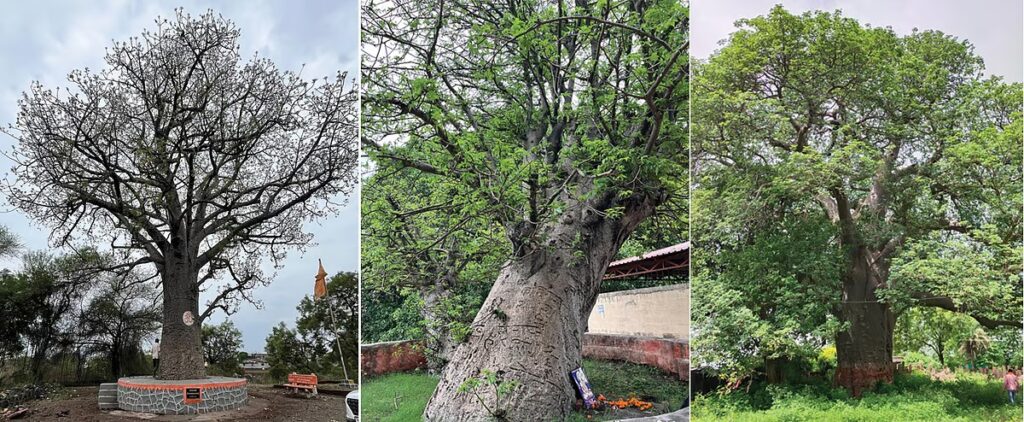
Recently, we found ourselves standing before an ancient baobab tree in Shirala, a small town nestled at the foothills of the Western Ghats in Sangli, where we had gone to attend a wedding. The tree stood with a majestic height of 22 metres just three kilometres from the wedding hall.
Its thick, twisted trunk was 6.35 m in girth and held up a canopy of leafless branches that looked like upside-down tree roots reaching up into the sky, standing out sharply against the blue background, as if the tree has been flipped upside down — a delightful marvel in the world of nature.
A local man was performing a puja, making 108 pradakshinas (circumambulations) around the tree. Being agroforestry practitioners, we were thrilled to witness this ancient marvel. The local man informed us that Shirala housed three baobab trees, but one had sadly been uprooted during the rainy season. The remaining two were well-preserved and revered by the locals.
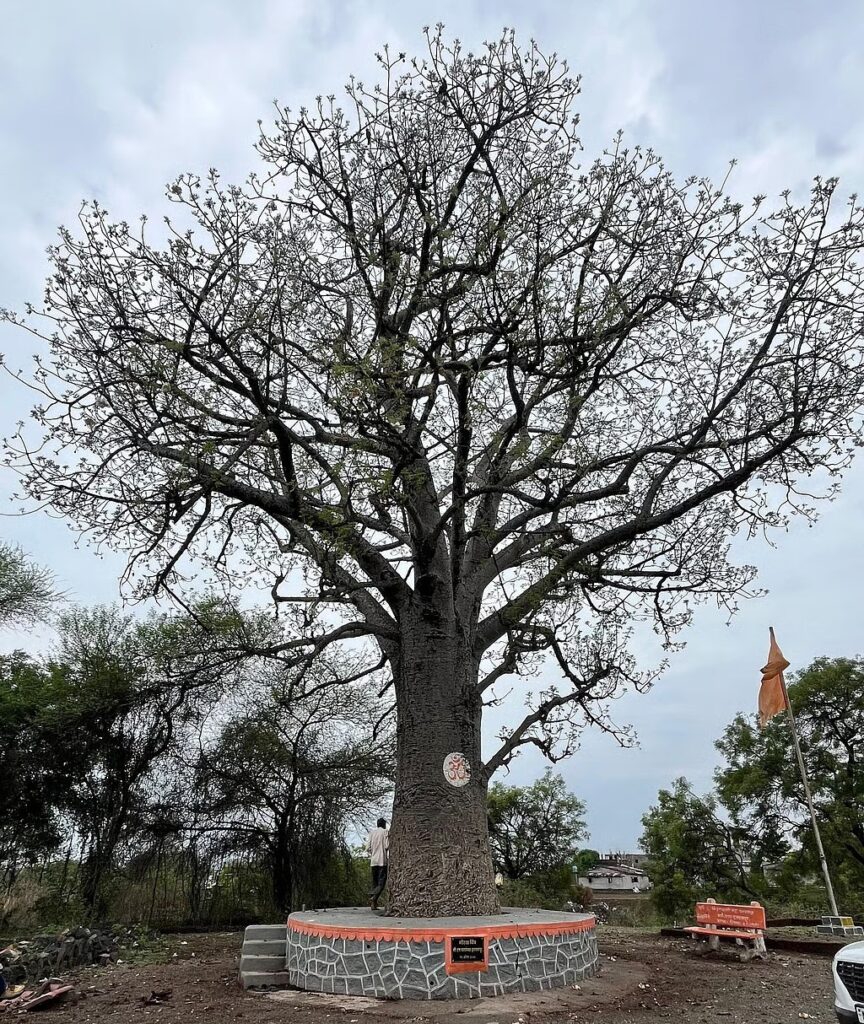
When we asked about their age, he humorously mentioned that these trees were planted by the great Maratha king, Shivaji Maharaj, on the Bhuikot fort of Shirala.
We went searching for the other baobab tree and were led to the backside of the oldest Gorakhnath Temple of Shirala. The temple priest estimated that these trees were around 200-250 years old. Inspired, we chatted about the history, characteristics, extent and significance of the baobab tree (Adansonia digitata) in India.

A natural ‘superfruit’
Adansonia digitata is native to Africa and belongs to the Malvaceae family. This tree is a true multi-purpose wonder, providing food, clothing, medicine and raw materials for various items. The name baobab is derived from the Arabic “bu hibab”, meaning “fruit with several seeds”. The tree is also known by other names such as the ‘dead-rat tree’ (due to its fruit’s resemblance to dead rats), the ‘monkey-bread tree’ (since monkeys eat its dry fruit), the ‘upside-down tree’ (because its bare branches resemble roots) and the ‘cream of tartar tree’ (due to the acidic taste of its fruit). In Hindi, it is referred to as gorakh-imli or gorak-chinch.
The tree commemorates the French botanist Michel Adanson, who studied Senegal’s natural history, with ‘digitata’ referring to the hand-shaped leaves.
There are eight species of Adansonia worldwide, found in Africa, Asia and Australia. The Adansonia digitata species, found in the Indian subcontinent, originally spread through the African savanna. These massive deciduous trees can grow up to 20-30 m tall, with a trunk diameter of 2-10 m. They have smooth, reddish-brown to grey bark with longitudinal fibres and a distinctive swollen, bottle-shaped trunk that stores water for dry seasons. The tree’s extensive root system helps it thrive and some baobabs are believed to live up to 5,000 years.
baobabs are incredibly resilient, resisting fire, termites and drought. They thrive in well-drained, acidic soils and have been introduced to many countries for ornamental purposes. baobabs bloom during the wet and dry seasons, producing large flowers on long peduncles. In southern Africa, they flower from October to December, with fruits appearing from April to May.
In India, they flower from May to June, aligning with the rainy season. They are gaining international prominence in the food, cosmetic and pharmaceutical industries.
During drought conditions, the hollow stem of the baobab tree is used to store water and can also serve as a shelter. The tree’s fibres are used for making ropes, mats and other items, while the leaves and seeds are used in soups and as flavouring agents.
The fruits are bottle- or cucumber-shaped, with a woody outer shell and a nutritious pulp high in vitamins C and B2. Their fruits and leaves are rich in nutrients, earning them the nickname ‘superfruit’ due to their high vitamin C and fibre content. Specifically, baobab fruit pulp contains 280-300 mg of Vitamin C per 100 grams, which is 10 times more than oranges, along with high levels of ascorbic acid (337 mg / 100 g). A 2021 study detailed the nutritional profile of a baobab fruit, highlighting its impressive nutrient content per 100 grams: 2.04-3.24g of protein, 0.4-0.7g of fat, 78.3-78.9g of carbohydrates, 45.8-53.9g of fiber, 257-370mg of calcium, 126-179 mg of magnesium, 74-163 mg of Vitamin C and 2,010-2,390 mg of potassium. Additionally, the seeds can be roasted and eaten as snacks, and the leaves are often used in cooking.
| Nutritional properties of baobab fruits | |||
| Macronutrients | Quantity (g/100 g) | Minerals/ Vitamins | Quantity (mg/100 g) |
| Protein | 2.04-3.24 | Sodium | 7-31.10 |
| Fat | 0.4-0.70 | Potassium | 2,010-2,390 |
| Total carbohydrate | 78.3-78.90 | Calcium | 257-370 |
| Total sugars (as glucose) | 16.9-25.30 | Magnesium | 126-179 |
| Total dietary fiber | 45.8-53.90 | Phosphorus | 56.10-73.30 |
| Pectin | 23.4-33.80 | Iron | 3.95-9.13 |
| Ash | 5.5-6.60 | Copper | 0.53-0.75 |
| Crude Protein (seed) | 16.60 | Zinc | 0.70-1.02 |
| Fat (seed) | 17.50 | Manganese | 0.65-1.30 |
| Available carbohydrate content | 16.9-25.30 | Vitamin C | 74.00-163.00 |
Baobabs in India: A heritage tree?
The baobab holds immense cultural and traditional significance in African communities and is mainly found in tropical Africa, the Indian Ocean islands and the Arabian Peninsula. It typically grows at low altitudes with 4-10 dry months per year.
According to the Guinness Book of World Records, the largest known living baobab tree is in Sagole, South Africa, near the Zimbabwe border. Its base covers about 60.6 square metres, with a height of 19.08 m and a total volume of 414 cubic metres. This tree, estimated to be 800 years old based on carbon dating, has a biomass of 54 tonnes.
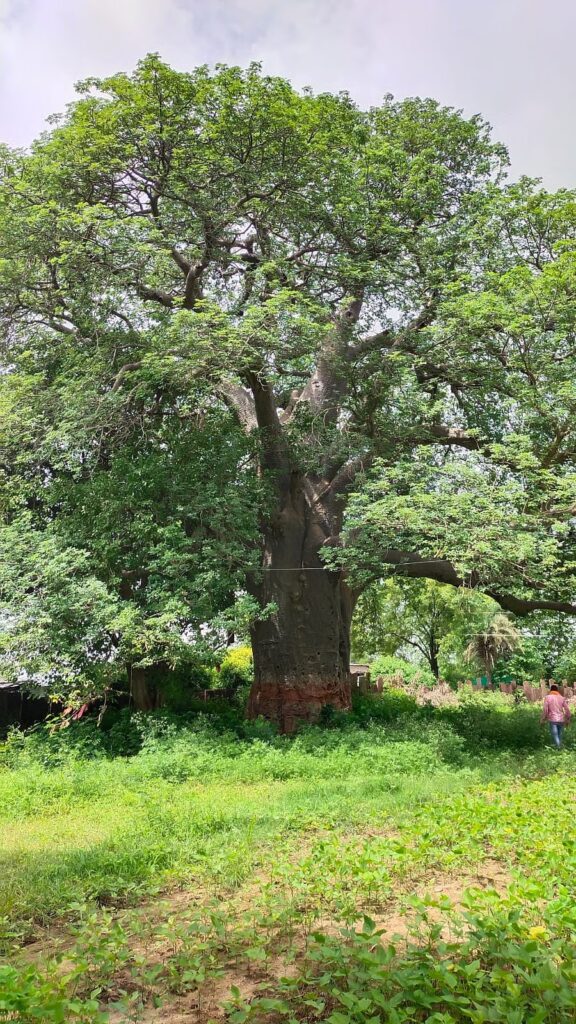
In India, baobabs are found in the semi-arid central areas to the wetter parts of the Western Ghats. Many baobab trees in India were introduced by African migrants, while others were brought by Arab and Portuguese traders. The largest baobab tree outside Africa in India is located at Golconda Fort and is over 400 years old, known locally as hatiyan jhad (elephant tree).
However, a study by Patrut (2020) using radio-dating techniques found that the baobab trees in Jhunsi (770±25 years), Allahabad and the Parijaat tree (775±25 years) in Kintoor are the oldest dated African baobabs outside of Africa.
Records indicate that over 1,000 baobab trees grow in Mandu, Dhar District of Madhya Pradesh. The Bhil community in this region preserves these trees and makes a living by collecting and selling various baobab products.
According to a blog by Nishi Bhatnakar, locals in Mandu believe the baobab seeds were brought by Afghan rulers of the Ghuri Dynasty during the reign of Hoshang Shah of Malwa. A 2015 study titled The History of Introduction of the African baobab (Adansonia digitata, Malvaceae: Bombacoideae) in the Indian Subcontinent concluded that the Indian baobab trees are related to those in Africa, though some genetic variations have occurred due to mutations. This suggests that baobabs were first introduced to India by African traders who settled in the region.
Social media & conservation
An Instagram account, @baobabs_of_bombay, is dedicated to identifying and protecting baobab trees in Mumbai. The account’s tagline is “On a mission to visit each baobab in Bombay, map and possibly get them protected by the government”. On Facebook, the group “baobabs of India”, created by Nelson OJ, provides insights into baobabs growing in India.
Many nature enthusiasts contribute by mapping and posting photos of baobab trees from different regions of the country. In India, baobab trees are revered by local communities for their conservation, with worship playing a crucial role in their protection by the people. Recently, the governor of Goa also visited the heritage tree baobab and paid his religious respect in Quepem, Goa. This act of religious and cultural reverence, along with the recreational values associated with these ceremonies, plays a significant role in aiding conservation efforts. By engaging in such activities, the community highlights the importance of trees, not only for their environmental benefits but also for their cultural and spiritual significance, fostering a deeper connection and commitment to preserving these vital natural resources.
The baobab tree, revered as the “Tree of Life” and “Mother of the Forest,” symbolises resilience and cultural richness, standing as a testament to nature’s enduring legacy.
Sangram B Chavan, senior scientist (Forestry / Agroforestry), ICAR-National Institute of Abiotic Stress Management; AR Uthappa, scientist (agroforestry), ICAR-Central Coastal Agricultural Research Institute, Goa; Amrut Morade, scientist (fruit science), ICAR NIASM; MK Bhargava, senior scientist (agronomy), RVSKKV-KVK, Shivpuri (MP) ; Vijaysinha Kakde, scientist (fruit science), ICAR NIASM.